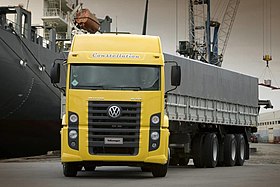| Volkswagen Constellation | |
|---|---|
 | |
| Overview | |
| Manufacturer | Volkswagen Truck & Bus |
| Production | 2005–present |
| Assembly | Resende, Brazil [1] Quezon City, Philippines (MACC) |
| Body and chassis | |
| Class | Commercial vehicle - truck |
| Body style | Tractor unit, Chassis cab, Flatbed - all "cab-over-engine" |


The Volkswagen Constellation is the flagship truck produced by the Brazilian manufacturer Volkswagen Truck & Bus since 2005. The line covering the 13-57 tonne gross combination mass (GCM) [1] segment. It is produced at Resende in Brazil, [1] and is primarily for the South American market.
Contents
The truck, a "cab-over-engine" released in September 2005, was designed in Volkswagen's Wolfsburg Design Studio at Volkswagen Group Headquarters, but engineered by Volkswagen Truck and Bus, in Brazil, South Africa, and mainland Europe - on a rigorous 7 million kilometre test phase over a four-year period. [2]
In 2006, Renato Martins won the Brazilian Fórmula Truck Championship in the Constellation's first season racing.